The promise of air taxis and streamlined cargo transportation necessitates a fundamental shift in infrastructure. At the heart of this lie vertiports, which come with environmental challenges that the industry must confront.
To achieve the necessary public acceptance for vertiports to become a mainstay within the aviation ecosystem, safety and environmental impact concerns must be addressed. This was evidenced recently in the response from policymakers in France to plans for eVTOLs to be flown over Paris when the city hosts the 2024 Olympic Games. Groupe ADP and Volocopter plan to site a special vertiport on the Austerlitz barge on the River Seine to facilitate flights across the French capital. However, in response to the proposal, local councillor Florian Sitbon said: “To save a few minutes for a few wealthy people in a hurry, who are ignorant and contemptuous of the climate emergency, we would be polluting the atmosphere and destroying the sound environment.”
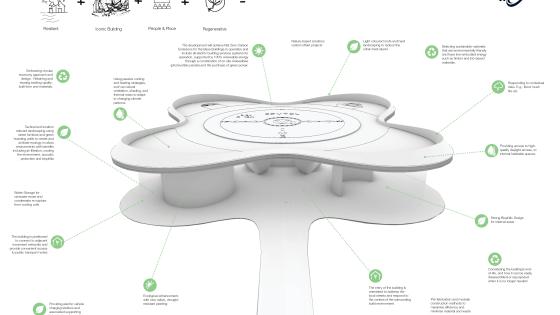
The Skyportz Vertistop has been designed by Contreras Earl Architecture with input from Arup
Key concerns
Noise pollution and power consumption are the main environmental threats from vertiports. To address this, in 2022, the European Union Aviation Safety Agency published the world’s first guidance for the design of vertiports: EASA’s Prototype Technical Design Specifications for Vertiports offers guidance to urban planners and local decision-makers as well as industry, to enable the safe and environmentally friendly design of the take-off and landing sites.
One innovation is the concept of a funnel-shaped area above the vertiport, designated as an “obstacle free volume” (OFV), which is tailored to the operational capabilities of VTOL aircraft. Not only will these OFVs enable omnidirectional trajectories to vertiports, but such approaches can more easily take account of environmental and noise restrictions. Defining how eVTOLs take off and land from vertiports is a critical element for both authorities and operators to address these twin concerns, regardless of relative low noise profile versus other aircraft and helicopters.
EASA also recently launched a digital space for the exchange of information on air taxis and drones, which it said was designed to reassure the public that their concerns about the introduction of these services in Europe’s cities are being fully addressed.
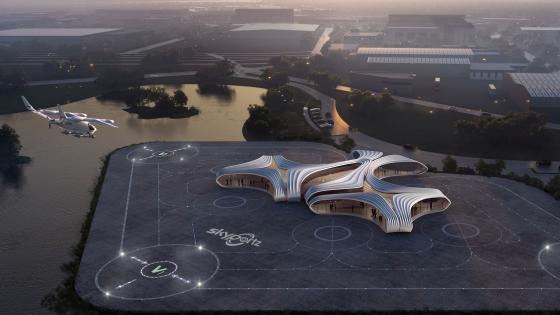
The vertiport will feature a high-performance roof designed to be structurally robust, lightweight and sustainable owing to its aluminium monocoque structure
The Innovative Air Mobility (IAM) Hub enables cities, regions, national authorities, operators and manufacturers who have a role in the introduction of these air taxi and drone services to share and obtain reliable information and data. EASA acting executive director Luc Tytgat said: “We want to demonstrate to citizens that Europe and EASA are putting everything in place to ensure a safe and sustainable introduction of these new aircraft. They will be able to find out how these services will work and gain reassurance on matters such as noise level and safety.”
Assessing the risk
Environmental impact assessments are a useful tool to help vertiport developers identify, mitigate and manage potential environmental risks, ensuring these new sites align with wider sustainability goals while contributing positively to the surrounding environment.
Researchers from the University of South Florida and Beihang University in China have contributed to the debate with a study focusing on the Tampa Bay area. After emission rate data was collected for different transportation modes, and the air pollutant emissions difference between ground transportation and multimodal urban air mobility (UAM) were compared, they found that compared to ground transportation modes, on-demand advanced air mobility (AAM) – including emissions linked to travel to and from the vertiports – emits more greenhouse gas and other air pollutants (such as PM2.5 particulates), while emitting fewer nitrogen oxides (NOx).
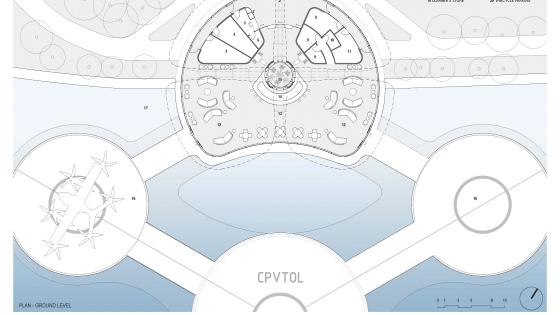
The new Melbourne vertiport will be a multimodal hub for electric scooters, bikes, ferries and hire boats
The researchers concluded: “The emissions depend on the structure of electric power production, as greenhouse gas emissions are related to the proportion of non-renewable energy in electricity production, and the other air pollutants are positively related to the proportion of oil and coal.”
Elisabeth Bernitt, a senior vice-president at infrastructure consultancy AECOM and co-leader of the firm’s eVTOL initiative, said: “As with all electric vehicles, eVTOL will increase energy demand.
“Grid upgrades will be needed to supply the energy required for battery charging and cooling. To complicate matters further, these aircraft are expected to vary in size, each with proprietary charging methods and requirements specific to the manufacturer. Because of this, these vertiports and vertistops will require facilities to support multiple eVTOL designs and charging types.”
The local environment
Vertiports will be deployed in urban, suburban and rural sites, but existing airports will likely become some of the first commercial locations – particularly as AAM operators look first to cargo as a test-bed before launching passenger flights. Nonetheless, engagement with local residents and other stakeholders is key to addressing concerns ranging from air quality to additional traffic on local roads.
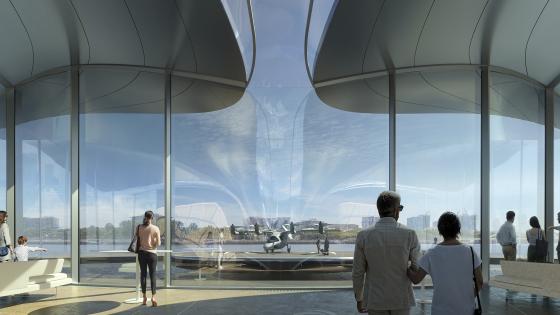
Vertiport design will vary according to usage as well as location
Clem Newton-Brown, CEO and founder of Skyportz, an Australian AAM infrastructure developer, says community support will be “critical” to the industry. Speaking to Airports International, he explained that while eVTOLs would be quieter and safer than helicopters, the industry still had some way to go to convince communities that the arrival of eVTOLs would not have a detrimental impact on their local environment. He said: “I expect that we will see eVTOLs using existing aviation infrastructure first and these early use cases will be critical in educating the public.
“Governments need to change their land use planning regulations to include a new type of land use – the vertiport. A vertiport needs to be much easier to get approval for than a heliport and we need to educate the regulators as to why eVTOLs should warrant special treatment. Air quality improvements are a good argument for replacing helicopters with eVTOLs.”
But he added: “For the expansion of aviation via a greatly increased number of eVTOL aircraft we can argue that this will have no impact on air quality. However, we still need to deal with the visual and noise pollution issues.”
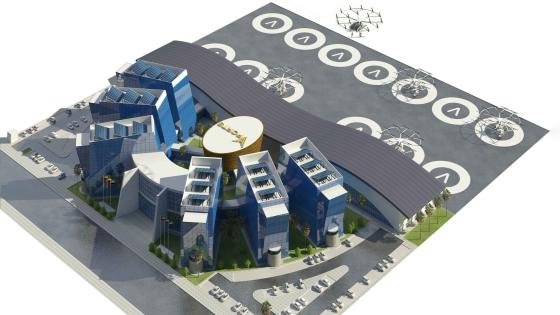
VPorts has begun the certification process for its Dubai vertiports
Multimodal sites
Skyportz was established in 2018 to lay the infrastructure groundwork for an air taxi ecosystem, involving regulatory and planning scheme changes, before moving on to building the network with property and logistics partners. The company is developing a comprehensive network in Australia to attract and support future urban and regional air mobility services.
The latest concept is for an Australian waterfront e-mobility hub on the Yarra River in Melbourne. Under the plan, the site would also be a multimodal hub for electric scooters, bikes, ferries and hire boats. Its stable of designs includes a large public vertiport, a smaller public waterfront vertiport and a tiny “Vertiport in Box” for private use. Crucially, Skyportz’s plans, made in conjunction with Contreras Earl Architecture and Arup, have sustainability baked in. Their single-pad vertiport sustainability strategy includes roof overhangs calibrated for shading, high-performance glazing and openable windows for natural ventilation. There is also consideration for power generation and heating/cooling equipment, with solar-thermal panels, photovoltaics, water-source heating/cooling and heat pumps.
Skyportz prototype designs also factor in elements such as rainwater collection and storage, vertical greening and underfloor air distribution. Richard Vincent, sustainable buildings leader at Arup, said of the proposals: “The infrastructure and buildings facilitating these innovative transportation modes must be designed with circular economy principles, climate resilience and zero emissions in order to achieve the best possible results for our planet and local communities alike.”

Construction of VPorts vertiports will begin in Dubai in 2024
Reduction, not elimination
Canada-headquartered VPorts is another vertiport trailblazer taking steps to reduce the environmental implications of these landing sites. Founder and president Fethi Chebli said that the AAM sector had a duty to be frank with the public, adding that while eVTOLs “will reduce carbon emissions, we are not eliminating them – we have to be very honest in explaining that”.
Chebli told Airports International that the introduction of eVTOLS would first come through the air cargo sector, which streamlined the certification process as well as avoiding some of the environmental consequences that will inevitably come with urban passenger flights. “We are starting with cargo and step by step we will, by 2035, see people starting to use eVTOLs for transportation within an urban setting. So we’re not flying overhead people straightaway. In Dubai, where we are operating, we will fly over highways and then over the sea.”
VPorts recently initiated the certification process for its vertiports as part of the world’s first AAM integrator centre at the Mohammed bin Rashid Aerospace Hub (MBRAH) in Dubai South. Construction of the vertiports starts in 2024. While eVTOLs themselves may not produce emissions during flight, as the US and Chinese researchers noted, life-cycle emissions including those linked to the generation of electricity necessary for their operation can result in significant emissions.
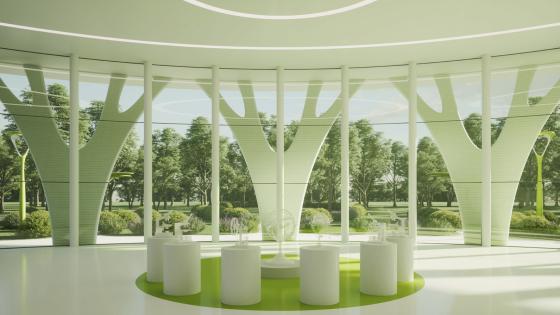
The Levi-Montalcini Foundation Vertiport will benefit from biomimicry and solar lighting
Renewables and their benefits
One solution to that problem is renewable electricity generation within the vertiport. VPorts is looking at South Carolina-based Sola Group’s Solapave as an innovative sustainable solar-powered paving system that could replace traditional Tarmac surfaces on the apron with solar technology to generate clean energy from sunlight combined with a battery storage solution and micro-grid distribution control.
Sola Group says its photocatalytic pavements for vertiports encompass wireless charging and improved ground operations, and feature a full LED infotainment display and a non-slip surface.
“We will be using technology to reduce our reliance on the grid,” Chebli added. “If we can use solar power, and there is technology today that will help us to do that, that would be perfect. Maybe we will need to use the grid for a period of time where it is less costly, and we can use solar power at other times to reduce our use of the grid.”
In November, Sola Group announced it was partnering with eVertiSKY, a provider of advanced ground space and airspace infrastructure for AAM based in Chicago. eVertiSKY has unveiled a blueprint for its Levi-Montalcini Foundation Vertiport in Italy, which will incorporate biomimicry and solar lighting into the design and construction. Sandra Formenton, CEO of eVertiSKY, said: “Our vision at eVertiSKY centres on integrating technologies, such as green materials and charging efficiencies, into our commitment towards sustainable urban air transportation.
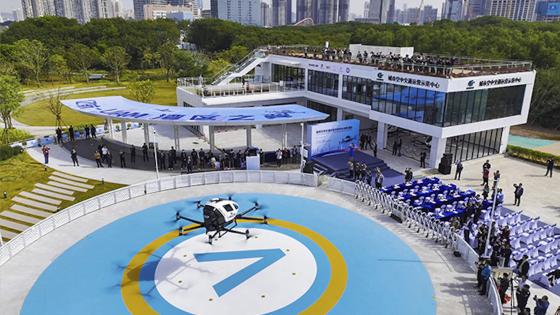
The new UAM Operation Demonstration Center (‘UAM Center’) at OH Bay, Bao’an district
EHang, an eVTOL technology platform, has also incorporated energy production into its eye-catching new vertiport design. Partnering with Italian architecture firm Giancarlo Zema Design Group (GZDG), the Chinese aerospace company has commissioned a “sustainable vertiport” in Italy using green design principles and construction materials that can generate its own energy to recharge EHang’s EH216 two passenger eVTOL multicopter. Inspired by the native African Baobab tree, GZDG came up with a design featuring a 30m-high tower with the take-off and landing platform set on the roof terrace. The vertiport is designed with non-slip photovoltaic panels that can generate more than 300KW of electric power per day and a fully independent plug-and-play charging infrastructure.
Another means of tackling the issue is greening the charging infrastructure for both aircraft and ground support equipment. Electro.Aero designs and builds aircraft charging solutions; its charging technology enables airports that lack sufficient grid power to upgrade their ground fleets to electrical power. The equipment can be charged by grid, generator or solar – reducing carbon from ground operations. Richard Charlton, CEO and co-founder of Electro.Aero, said: “Vertiports, like airports, will need to be able to handle charging multiple electric aircraft at 500kW+ peak load per aircraft.
“In the vast majority of cases, the grid connection will not be enough, so they will need battery energy storage systems, which slow charge in advance, then provide very rapid boost charging on demand,” he told Airports International. “Our new Aerocharge system has been designed to do this specifically for airports and vertiports, and is receiving strong interest globally right now.”
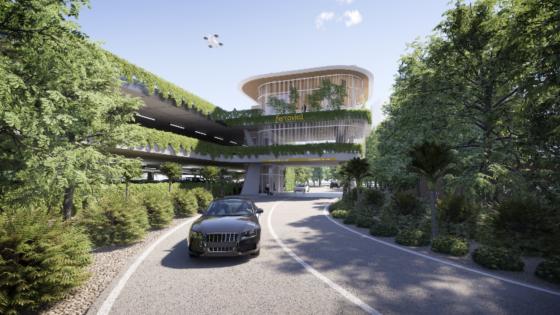
Vertiport developers are using data to identify optimal locations and estimate user demand
Harnessing big data
The impact of vertiports on ground transportation is equally complex. While proponents of eVTOLs as urban air mobility vehicles argue that they could lead to a reduction in polluting ground transportation – replacing a private car or taxi on a cross-town commute, for example – there is a risk that vertiports may also add traffic to the local road network from future AAM passengers.
Ferrovial Vertiports, an airport infrastructure management company that is developing a network of more than 20 interconnected vertiports in Spain, has been working with DatActionS, a big data specialist, to identify optimal locations and estimate user demand. This, the company believes, will give its vertiport network the best chance of reducing car trips, road congestion and CO2 emissions by pinpointing areas that will be best served by flying taxis.
All of Ferrovial’s vertiport infrastructure and services will make use of green energy where possible, and the company also plans to provide the vertiports with suitable areas for parking both eVTOLs and terrestrial electric vehicles, as well as charging stations.
Materials and modules
According to Dutch vertiport developer Bayards, contractors must also rethink the materials used to construct vertiports if they want to be more eco-friendly. Swapping steel for aluminium is one way to do that, the company reported: “Aluminium structures can be up to 60% lighter than their steel equivalents, saving high costs in supporting structures.
“An additional beneficial consequence of this weight reduction is that no heavy lifting equipment is required, thus saving costs on installation and transportation of the installation team’s materials. Less transport, less fuel consumed, less pollution generated, fewer costs involved, less CO2.”
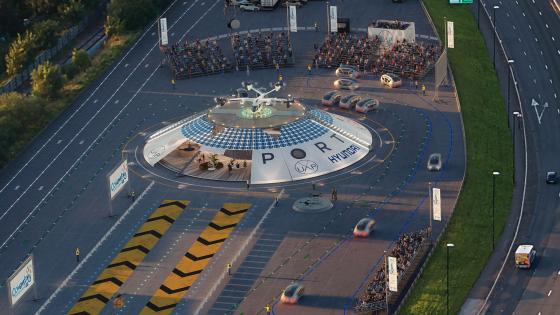
Air One, the world’s first fully operational Urban-Air Port for drones and electric vertical take-off and landing aircraft
Developers are also exploring solutions to reduce waste material associated with the construction and demolition of vertiports. Some are pioneering the concept of modular vertiports, designed to be constructed and dismantled with relative ease. This approach allows for more efficient deployment while minimising disruption to the surrounding environment during both installation and potential relocations. Modular vertiport designs promise a quicker setup process, reducing the duration of construction-related disturbances and offering a flexible solution that aligns with the dynamic needs of urban landscapes.
One such operator is Urban-Air Port, whose Air One vertiport prototype offers a unique multi-stacked hangar that provides an 8+ stand vertiport configuration using 80% less land than a conventional design. Hyundai Motor Group, Coventry City Council and the UK government have partnered with Urban-Air Port to launch the first Air One in the West Midlands.
Urban-Air Port plans to develop more than 200 sites in the next five years to meet global demand. The company says the physical footprint of its vertiport is 60% smaller than a traditional heliport (the most comparable existing infrastructure) and, using innovative construction, the sites can be installed in a matter of days, emit net zero carbon emissions and can be operated completely off-grid, meaning they do not always have to rely on a suitable grid connection. The design also enables the facilities to be easily moved to alternative sites, reducing the waste from construction and demolition of sites as the air-mobility sector develops.
As these developments continue to evolve, the collective efforts of vertiport stakeholders signal a promising shift towards an environmentally conscious future, where urban air mobility seamlessly coexists with sustainable practices.
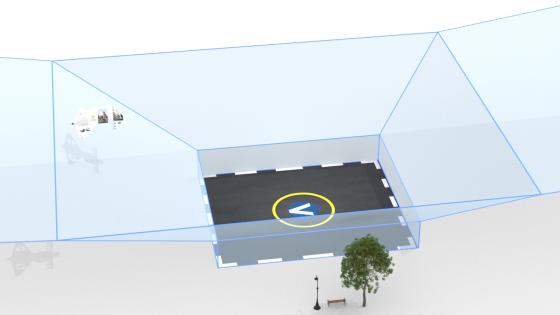
The concept of a funnel-shaped area above the vertiport has been designated an ‘obstacle free volume’
FURTHER READING: The case against
Limiting the environmental burden of vertiports is a central challenge for the industry, but even the most ambitious sustainable practices may not be enough to satisfy environmental experts who point to the AAM sector’s wider carbon footprint.
Catalina Turcu is Professor of Sustainable Built Environment at University College London’s Bartlett School of Planning. She said the most environmentally friendly response to AAM infrastructure was simply not to build it at all: “Vertiports are part of on-demand urban air mobility modes of transportation and research shows that this type of transportation generates more greenhouse gases [GHG] and other pollutants than commercial flights, ie, not on a par with private jet flights but close.
“We also know that, more widely, the aviation sector is a big contributor to GHG emissions. They should not be built in the first place.”
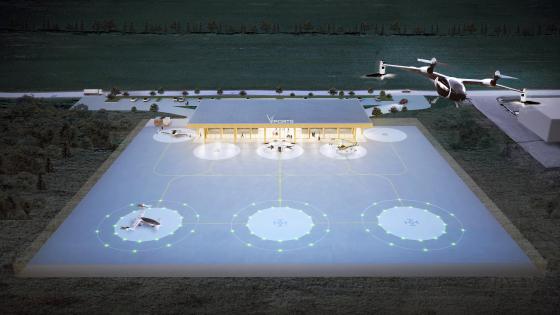
Their urban locations mean vertiports will be under special scrutiny when it comes to the environment
FURTHER READING: Rules and regulations
Urban planners must meticulously consider factors such as land use, transportation networks, community integration and environmental implications when envisioning the implementation of vertiport infrastructure.
In the United States, planners must adhere to the National Environmental Policy Act, known as NEPA, which requires federal agencies to assess the environmental effects of their proposed actions prior to making decisions. In 20 US states, additional local environmental reviews are also required. A NASA-produced study of vertiport requirements states: “Once a baseline for the affected environment is established under NEPA and any relevant state law guidelines, then the local jurisdiction must assess if there are additional studies that should be conducted to fully assess any environmental impacts that may occur as a result of a vertiport location or operations.”
The study had input from Gabriela Juárez at the City of Los Angeles Department of City Planning. The document notes: “The emergency landing sites associated with a proposed vertiport must also be considered as part of the environmental assessment to ensure that the environmental issues associated with these emergency sites are also factored into the environmental analysis.
“Noise and potential emissions concerns need to be assessed to assure that the NEPA and any relevant local levels are met, otherwise additional mitigations may be required. Assessment of any potential environmental justice impacts must also be reviewed at the local level to ensure that potential unintended consequences from the vertiport or associated transportation planning decisions are identified and addressed.”
